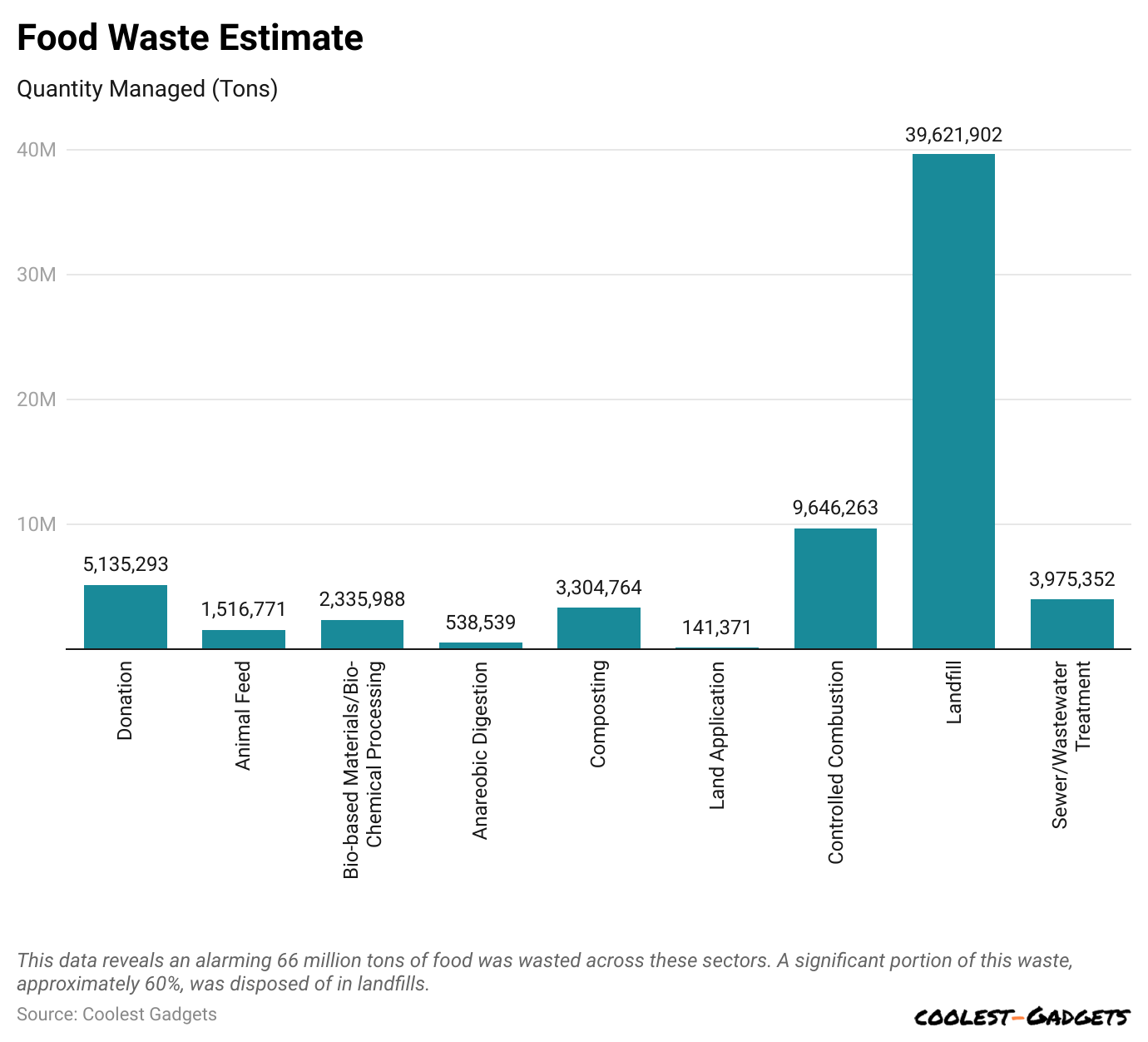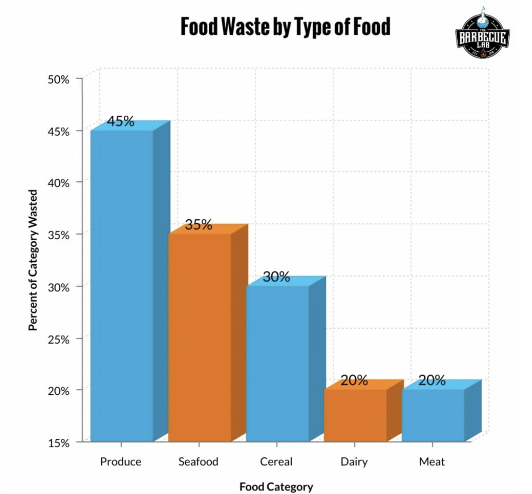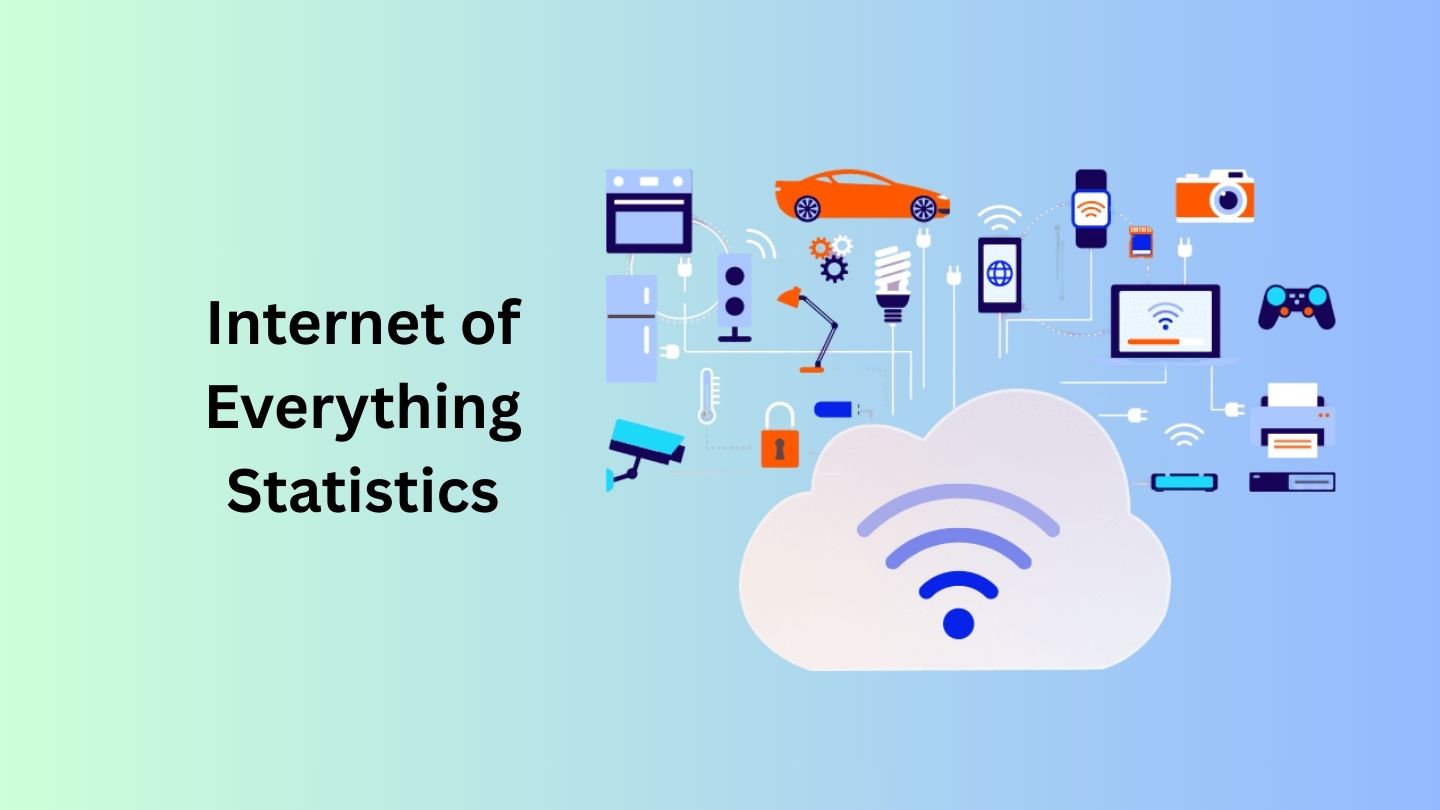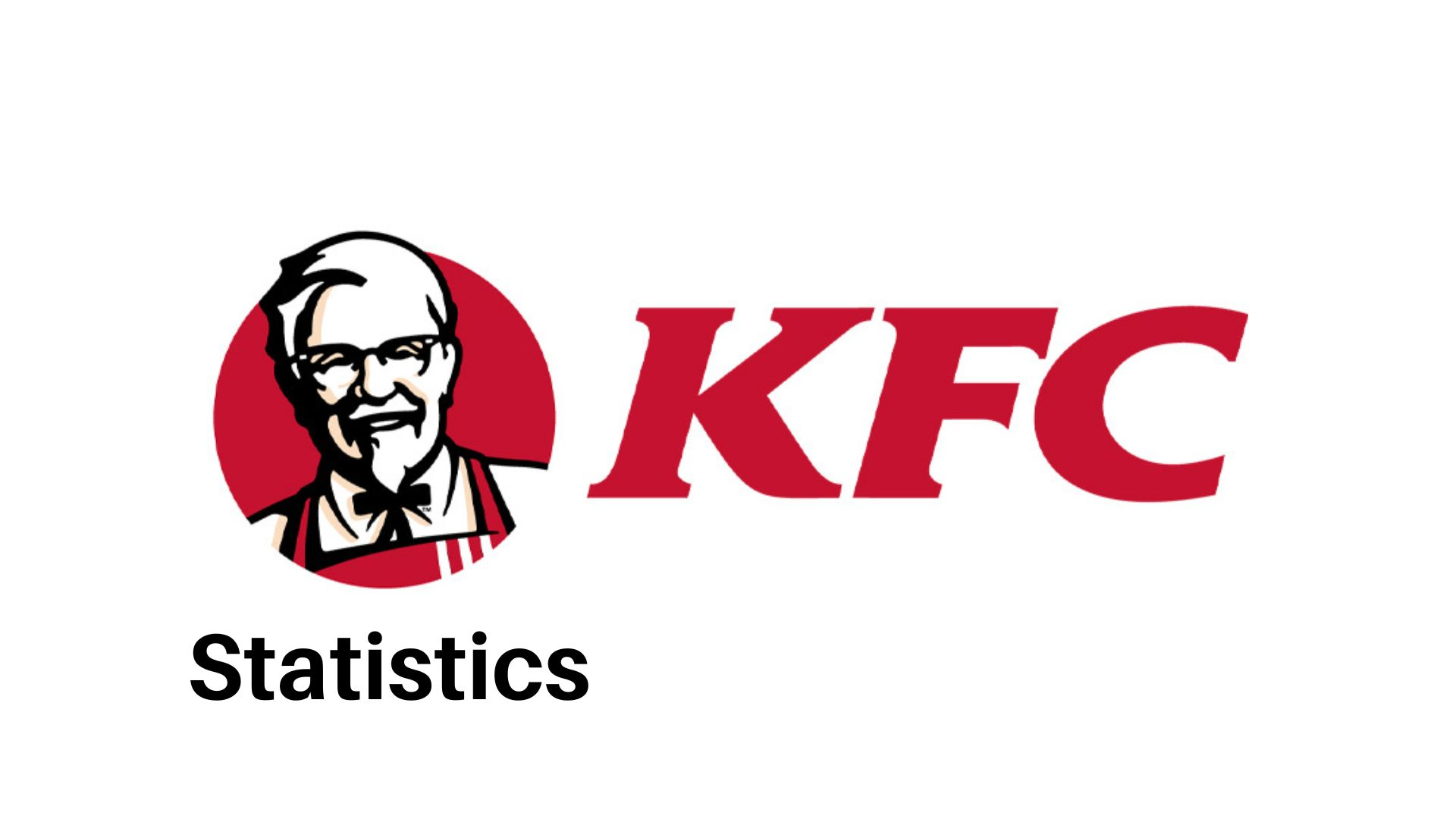Food Waste Statistics By Region, Types of Food Wasted, Food Category, Per Capita and Management Pathway

Updated · Mar 10, 2025


TABLE OF CONTENTS
- Introduction
- Editor’s Choice
- Food Market by Region
- Revenue By Product Category in Trillion Dollars
- General Food Waste Statistics
- By Annual Average Global Food Loss and Waste
- By Types of Food Wasted
- By Management Pathway
- Top Countries with Food Waste By Per Capita
- Worldwide Food Waste Disposal Market Value
- By Food Category
- Battling Food Waste with Tech
- Conclusion
Introduction
Food Waste Statistics: Although we call ourselves civilized, we still waste food. Food waste is a global issue that leads to severe environmental and economic damage. The larger the population, the more food waste in the country. However, the population is one of many factors that cause the highest amount of food waste; illiteracy about food’s importance in low-income countries also increases food waste.
Following is a Food Waste Statistics guide on the Worldwide Food market in 2024 and general Food Waste by number around the world.
Editor’s Choice
- The World Counts, the environmental cost of one meal delivery to one individual, whether wasted or consumed, is as follows: 800 liters of water, 10 kilograms of topsoil, 3.5 kilograms of CO2-emissions, 1.3 liters of diesel, and 0.3 grams of pesticides.
- Americans waste around 40 million tons of food, which accounts for 30 to 40% of the total US food supply.
- on average, 1.3 billion tons of food is wasted or lost every year.
- As of 2024, the American Food market is estimated to generate a revenue of $1,963 billion, and between 2024 and 2029, it will grow at a CAGR of 4.98%.
- Every year, on average, $1,000,000,000,000 is the economic consequence of worldwide food waste.
- As of March 2024, greenhouse gas emissions from food waste have added 10,204,875,000 tons of CO2 to the environment.
- In 2024, the average volume per person in the global Food Market is estimated to be 352.30 kg.
- 28% of the world’s total agricultural land used to produce food is wasted or lost, which makes 1.4 billion hectares.
- The World Counts report estimates that if the worldwide food systems are not made sustainable, then the earth will be running out of food in 25 years.
- 40% of the produced food around the world ends up in waste. This 40% can solve the global hunger problem without wasting food. In addition, the mentioned percentage can provide ten meals a day to undernourished people every day.
You May Also Like To Read
Food Market by Region
Worldwide
- The worldwide Food market is currently valued at $10.07 trillion.
- It is estimated that between 2024 and 2028, it will grow at a CAGR of 6.53%.
- In global markets, the majority of the revenue is estimated to be generated from China, resulting in $1,630 billion in 2024.
- By 2028, the food market volume is estimated to amount to 3,118.00 billion kg.
- In 2024, the average volume per person in the global Food Market is estimated to be 352.30 kg.
- Furthermore, in the global market, the majority of the sales are expected to be generated from online sales in the current year.
- As of 2024, the per-person revenue is expected to amount to $1,299.
- In the global food market, the Confectionery and Snacks segment is projected to be the largest food category by market volume, with $1.77 trillion in 2024.
Revenue By Product Category in Trillion Dollars
Revenue (2024)
- Vegetables ($1.08)
- Sauces and Spices ($0.26)
- Spreads and Sweeteners ($0.27)
- Pet Food ($0.15)
- Meat ($1.47)
- Oils and Fats ($0.25)
- Fruits and nuts ($0.86)
- Fish and Seafood ($0.68)
- Confectionery and Snacks ($1.77)
- Dairy Products and Eggs ($1.17)
- Convenience Food ($0.65)
- Baby Food ($0.08)
- Bread and Cereal Products ($1.37)
Revenue (2025)
- Vegetables ($1.16)
- Sauces and Spices ($0.28)
- Spreads and Sweeteners ($0.29)
- Pet Food ($0.16)
- Meat ($1.57)
- Oils and Fats ($0.27)
- Fruits and nuts ($0.92)
- Fish and Seafood ($0.73)
- Confectionery and Snacks ($1.88)
- Dairy Products and Eggs ($1.26)
- Convenience Food ($0.70)
- Baby Food ($0.08)
- Bread and Cereal Products ($1.48)
Revenue (2026)
- Vegetables ($1.25)
- Sauces and Spices ($0.30)
- Spreads and Sweeteners ($0.32)
- Pet Food ($0.17)
- Meat ($1.67)
- Oils and Fats ($0.29)
- Fruits and nuts ($0.99)
- Fish and Seafood ($0.78)
- Confectionery and Snacks ($2.00)
- Dairy Products and Eggs ($1.36)
- Convenience Food ($0.75)
- Baby Food ($0.08)
- Bread and Cereal Products ($1.59)
Revenue (2027)
- Vegetables ($1.33)
- Sauces and Spices ($0.32)
- Spreads and Sweeteners ($0.34)
- Pet Food ($0.18)
- Meat ($1.77)
- Oils and Fats ($0.31)
- Fruits and nuts ($1.05)
- Fish and Seafood ($0.82)
- Confectionery and Snacks ($2.11)
- Dairy Products and Eggs ($1.45)
- Convenience Food ($0.79)
- Baby Food ($0.09)
- Bread and Cereal Products ($1.69)
Revenue (2028)
- Vegetables ($1.41)
- Sauces and Spices ($0.33)
- Spreads and Sweeteners ($0.36)
- Pet Food ($0.19)
- Meat ($1.88)
- Oils and Fats ($0.33)
- Fruits and nuts ($1.11)
- Fish and Seafood ($0.87)
- Confectionery and Snacks ($2.22)
- Dairy Products and Eggs ($1.55)
- Convenience Food ($0.84)
- Baby Food ($0.09)
- Bread and Cereal Products ($1.79)
Asia
- The Asian food market is expected to amount to $4,929.00 billion in 2024.
- Furthermore, it is expected that it will grow at a CAGR of 6.71% between 2024 and 2028.
- The per-person revenue in the Asian Food market is estimated to amount to $1,082.00 in 2024.
- By 2028, the Asian Food Market volume is estimated to amount to $1,850.00 billion kg.
- Moreover, most of the sales are estimated to be generated from online mediums in 2024.
- In 2024, Bread and Cereal Products is estimated to be the largest segment with a market volume of $808.80 billion.
Americas
- As of 2024, the American Food market is estimated to generate a revenue of $1,963 billion, and between 2024 and 2029, it will grow at a CAGR of 4.98%.
- The per-person revenue is projected to amount to $1,926 in 2024.
- Furthermore, the average volume per person in the American food market is estimated to amount to 443.00 kg in the current year.
- In the American market, the Confectionery and Snacks segment is also estimated to be the largest food category by market volume, with $449.30 billion in 2024.
- Around 7.8% of revenue will be generated from online sales, with the highest contribution of 7.8% in 2024.
Africa
- The African market is estimated to generate a revenue of $941.90 billion in 2024 and is expected to grow at a CAGR of 10.61% between 2024 and 2028.
- The Confectionery and Snacks segment is projected to be the largest market in Africa in 2024, with a $204.10 billion market volume.
- The Food market’s volume is projected to amount to 251.30 billion kg by 2028, with a growth rate of 4.3% in 2025.
- In 2024, the average volume per person is estimated to be 168.60kg.
Australia and Oceania
- As of today, the revenue in the food market is estimated to be $114.30 billion.
- Furthermore, it is projected to grow at a CAGR of 4.86% between 2024 and 2028.
- The per-person revenue in the Australian and Oceania market is projected to amount to $2,712.
- The meat segment is estimated to be the largest food category in the market, with a volume of $23.46 billion in 2024.
- The average volume per person is projected to be 527.30kg in the current year.
- In addition, by 2028, the volume is projected to reach 4.49 billion, with a growth rate of 2.6% in 2025.
Europe
- In the European food market, the average volume per person is estimated to be 533.10kg in the current year.
- The per-person revenue is expected to amount to $2,494.
- Furthermore, the Meat category is expected to be the largest segment, contributing $410.50 billion in market volume in 2024.
- In 2024, the majority of the revenue is estimated to be generated from online sales, resulting in 2.5%.
General Food Waste Statistics
- Food waste is a significant contributor to climate change, representing 3.3 billion tons of carbon footprint.
- Most food is wasted at food service providers, retailers, and households (17%), between the farm gate and retail sector (14%), and on farms (8%).
- on average, 1.3 billion tons of food is wasted or lost every year.
- According to a report by The World Counts, the environmental cost of one meal delivery to one individual, whether wasted or consumed, is as follows: 800 liters of water, 10 kilograms of topsoil, 3.5 kilograms of CO2-emissions, 1.3 liters of diesel and 0.3 grams of pesticides.
- In addition, The World Counts report estimates that if the worldwide food systems are not made sustainable, then the earth will be running out of food in 25 years.
- Every year, 1,300,000,000,000 kilograms of food is wasted.
- As of March 2024, greenhouse gas emissions from food waste have added 10,204,875,000 tons of CO2 to the environment.
- wasting one burger wastes water equal to 90 minutes of showering.
- Every month, an American wastes around 20 pounds of food.
- 40% of the produced food around the world ends up in waste. This 40% can solve the global hunger problem without wasting food. In addition, the mentioned percentage can provide ten meals a day to undernourished people every day.
- In the USA alone, the annual food waste on average is between $161 billion to $218 billion.
- Every year, an American family of 4 wastes $1,500 of food.
- 28% of the world’s total agricultural land used to produce food is wasted or lost, which makes up 1.4 billion hectares.
- Every year, on average, $1,000,000,000,000 is the economic consequence of worldwide food waste.
- Americans waste around 40 million tons of food, which accounts for 30 to 40% of the total US food supply.
- fruits, vegetables, and bread are the most wasted foods on a household level.
- Furthermore, 45% of fruits and vegetables produced worldwide are wasted every year.
- 70% of worldwide wasted food is uneaten food that is edible.
By Annual Average Global Food Loss and Waste
- Fruits and vegetables (45%)
- Fish and Seafood (35%)
- Dairy Products (20%)
- Meat and Poultry (20%)
- Cereals (30%)
According to Food Waste Statistics, the average of all waste food categories makes ⅓ of the world’s food, 1.3 billion tons, with a value of $1 trillion.
By Types of Food Wasted
| Industry | Category | Estimated quantity | Share in total wasted food annually | Types of Food Waste |
| Residential | Multi-family, single-family households, dormitories | 570 million tons | 16% | Spoiled food, expired products, plate waste, over-purchasing |
| Food Service | Restaurants, fast food chains, cafes | 224 million tons | 26% | Kitchen trimmings, spoilage, expiration, plate waste, uneaten prepared food, overproduction |
| Food Retail | Convenience stores, Grocery stores, Supermarkets | 118 million tons | 13% | Damaged goods, overstock items, unsold produce, expired products |
(Source: greenmatch.co.uk)
By Management Pathway

(Reference: greenmatch.co.uk)
According to the Food Waste Statistics, around 66 million tons of food are wasted in the above industries. However, the majority of the food, contributing 60%, was discarded into landfills, resulting in 39,621,902 tons. In addition, the share of other food waste management pathways is as follows: Donation—7.8%, animal feed -2.3%, bio-based—3.5%, composting—5%, controlled combustion—14.6%, and sewer or wastewater—6%.
Top Countries with Food Waste By Per Capita
| Top Countries with Food Waste | To Countries by per capita food waste |
| China, 91.6 million tons | Australia, 361 kg per person annually |
| India, 68 million tons | United States, 278 kg per person annually |
| United States, 19 million tons | Greece, 141 kg per person annually |
| France and the United Kingdom, 5 million tons | United Kingdom and Spain, 77 kg per person annually |
| Russia, 4 million tons | India, 50 kg per person annually |
(Source: greenmatch.co.uk)
Worldwide Food Waste Disposal Market Value
| Year | Market Value (In billion dollars) |
| 2018 | 7.32 |
| 2019 | 7.8 |
| 2020 | 7.46 |
| 2021 | 7.91 |
| 2022 | 8.36 |
| 2023 | 8.86 |
| 2024 | 9.37 |
| 2025 | 9.89 |
| 2026 | 10.43 |
| 2027 | 10.98 |
| 2028 | 11.55 |
| 2029 | 12.13 |
| 2030 | 12.72 |
| 2031 | 13.33 |
| 2032 | 13.98 |
(Source: statista.com)
By Food Category

(Source: thebarbecuelab.com)
Food Waste Statistics show that fresh products are the leading type of food waste, contributing 45%. Seafood and Cereal share 35% and 30% respectively. Dairy and meat share the contribution equally, at 20%.
Battling Food Waste with Tech
Food waste is a massive global problem. Did you know around one-third of all food produced gets lost or wasted every year? That’s a staggering amount, especially when hundreds of millions of people around the world struggle with hunger. But there’s a ray of hope: technology is emerging as a powerful weapon in the fight against food waste. Here’s how tech is making a difference in 2024:
Smarter Farming for Less Spoilage:
- Precision Agriculture with Drones and Sensors: Imagine drones zipping over fields, collecting data on crop health and environmental conditions. This data, analyzed by AI (Artificial Intelligence), helps farmers pinpoint areas needing more or less water, fertilizer, or pest control. This precision approach can significantly reduce crop loss before harvest.
- IoT (Internet of Things) for Storage and Transport: Tiny sensors embedded in storage units and trucks can monitor temperature, humidity, and even spoilage gas levels. Real-time data allows for adjustments in storage conditions or faster delivery of perishable goods, preventing spoilage during transport.
Optimizing the Supply Chain:
- AI-powered Demand Forecasting: Predicting how much food will be needed at stores and restaurants is a tricky business. AI algorithms are getting smarter at analyzing past sales data, weather patterns, and even social media trends to forecast demand more accurately. This helps reduce overstocking, which can lead to spoilage later.
- Blockchain for Transparency: Blockchain technology, known for its secure record-keeping in cryptocurrencies, is finding new use in food supply chains. It allows everyone involved—from farmers to distributors to retailers—to track food origin, movement, and expiration dates in real-time. This transparency helps identify bottlenecks and inefficiencies that lead to waste.
Saving Food at the Store and Restaurant Level:
- Dynamic Pricing with AI: Imagine grocery stores automatically discounting soon-to-expire items. AI can analyze inventory and suggest price reductions for nearing-expiry items, making them more attractive to consumers and reducing waste.
- Food-Sharing Apps for Surplus Rescue: Apps like Too Good To Go connect consumers with restaurants and stores that have surplus food approaching its expiry date. Users can buy these items at significantly discounted prices, preventing them from being thrown away.
Empowering Consumers to Reduce Waste:
- Smart Fridge Management Systems: Imagine your fridge telling you what’s about to expire and suggesting recipes to use those ingredients. Smart fridge technology is evolving with built-in cameras and sensors that can track food inventory and expiry dates.
- Meal Planning and Leftover Management Apps: These apps help plan meals based on dietary needs and existing groceries, reducing impulse purchases that can lead to waste. They can also suggest creative recipes using leftovers, preventing them from ending up in the trash.
Beyond Saving Food, Rethinking Waste:
- Advanced Composting Technologies: Traditional composting can be slow and inconvenient. New technologies like aerobic digesters and vermicomposting (using worms) break down food scraps into nutrient-rich compost much faster. This valuable compost can then be used to grow more food, creating a closed-loop system.
- Waste-to-Energy Conversion: Food scraps that can’t be composted can be converted into biogas or electricity through advanced waste-to-energy technologies. This reduces reliance on landfills and creates usable energy from what would otherwise be waste.
The Road Ahead
Technology offers a powerful toolbox for tackling food waste. As these technologies become more affordable and accessible, we can expect a significant reduction in food waste across the globe. However, tech solutions are just one piece of the puzzle. Educating consumers about proper food storage, planning meals to avoid waste, and supporting businesses that prioritize sustainability are all crucial aspects of creating a more food-secure future. With a combination of technological innovation and a shift in consumer behavior, we can turn the tide on food waste and ensure everyone has access to the food they need.
Conclusion
Food waste is a major cause of hunger issues in low-income countries around the world. The amount of food we waste today can satisfy the hunger of people fighting for food every day. Although we are living in “the future,” the problems are decades old, and unfortunately, only a few people are looking for solutions.
It is important to create a sustainable environment to save our blue planet. As stated in these Food Waste Statistics, if no actions are taken to reduce food waste, after two decades, there will be no food left for human consumption.
Sources

Pramod Pawar brings over a decade of SEO expertise to his role as the co-founder of 11Press and Prudour Market Research firm. A B.E. IT graduate from Shivaji University, Pramod has honed his skills in analyzing and writing about statistics pertinent to technology and science. His deep understanding of digital strategies enhances the impactful insights he provides through his work. Outside of his professional endeavors, Pramod enjoys playing cricket and delving into books across various genres, enriching his knowledge and staying inspired. His diverse experiences and interests fuel his innovative approach to statistical research and content creation.











